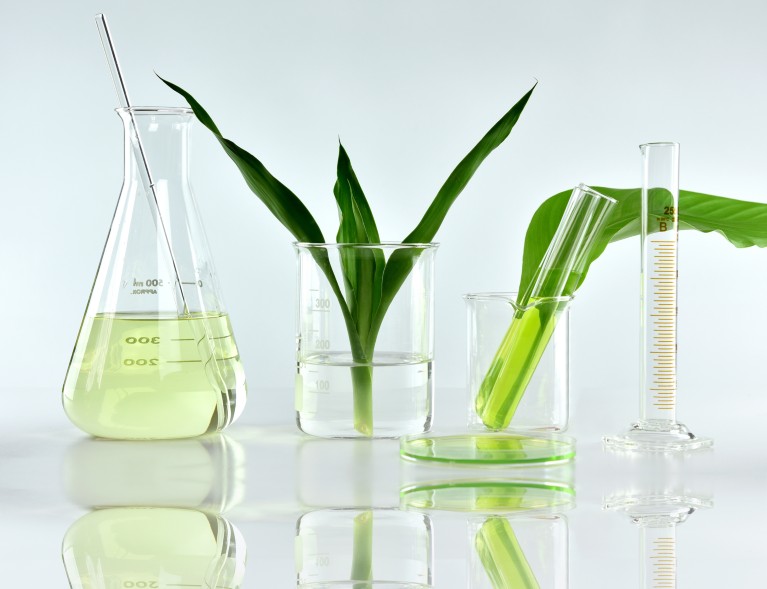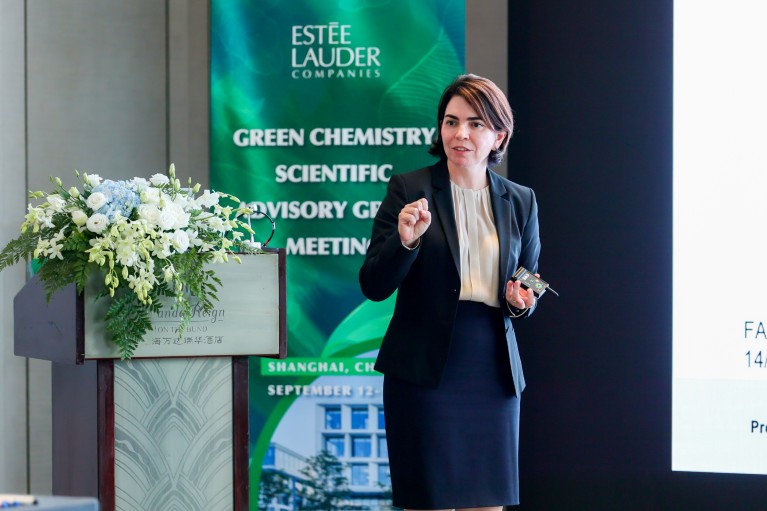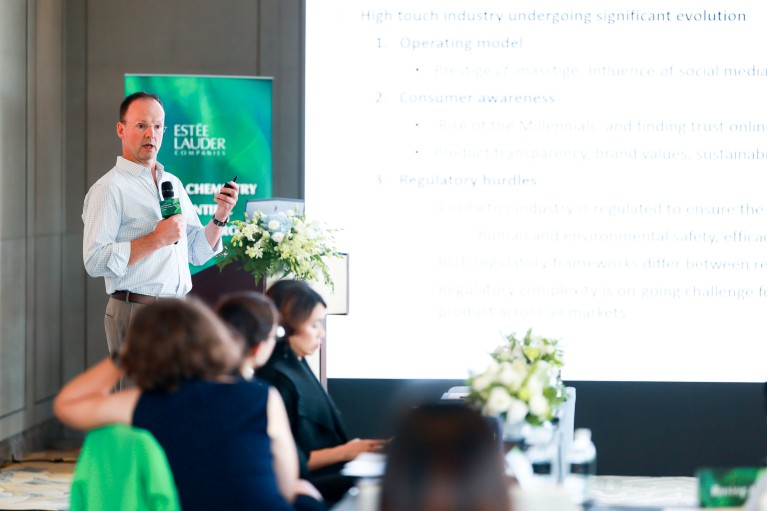January 17, 2024
(press release)
–
Green Chemistry is the path to sustainability for many different types of product.Credit: Artfully79/ Getty Images Only part of the resources that are extracted from the Earth are transformed into products; most end up as waste, says Buxing Han, a green chemist at the Institute of Chemistry, Chinese Academy of Sciences in Beijing, and chair of the Interdivisional Committee on Green Chemistry for Sustainable Development of the International Union of Pure and Applied Chemistry (IUPAC). However, these mountains of waste, and the environmental damage they may cause, can be avoided by following certain design principles with “green chemistry being a way to sustainability” he says. Han was the guest of honour among 10 leading experts who gave talks and participated in panel discussions at the ‘Green Chemistry Scientific Advisory Group Meeting’ held by global cosmetics organization Estée Lauder Companies (ELC) in Shanghai, 12–13 September 2023. The event focused on updating ELC’s Green Score — a tool it created that enables every formulator to assess the sustainability of cosmetic-product formulations in real time. The discussion also covered the latest principles and approaches to green chemistry, with a special focus on research from the Asia Pacific region. Unlike the legacy attitude of cleaning up waste after the fact, green chemistry strives to get things right the first time by reducing potential pollution and minimizing or eliminating hazards upfront. The 12 principles of green chemistry were established by Paul Anastas and John Warner1 in 1998. These principles hold true for every industry and, if distilled into a similar framework such as ELC’s Green Score2, the sustainability impact across the value chain could be transformative. ELC’s Green Score For many years, ELC has believed that the whole cosmetics industry could benefit from clear guidance on how to approach the complex question of product sustainability. This is not a straightforward task for any manufacturer or downstream user of a finished good, be that food, clothing, wearable electronics or household cleaning products. However, cosmetics — which range from personal care products to hair and skin care products, decorative/colour products and various other product types — contain a multitude of constituents all with distinct chemistries and in diverse combinations that shape their sustainability profiles. ELC addressed this complexity by distilling key green chemistry principles into a scoring rubric that enables formulators to systematically assess the sustainability of each raw material, giving an overall Green Score for a product. This approach was validated by ELC’s Green Chemistry Scientific Advisory Group (SAG), comprised of academic experts from China, Europe, North America and Latin America, and published2 in Green Chemistry in 2022. The first iteration of the Green Score encompassed 4 of the 12 principles of green chemistry, essentially: a better selection of chemistries; pollution prevention; energy efficiency; and use of renewable feedstocks. This meeting introduced the Green Score 2.0, which doubled the number of green chemistry principles to 8, to now include preventing waste, maximizing atom economy, more benign chemical syntheses, and design for degradation (see ‘Green Score: Alignment to 12 Principles of Green Chemistry’). In parallel, ELC says its researchers are continuing to enhance the quality and relevance of scientific data used in the framework, particularly the potential for chemicals to be biodegradable. Green Score 2.0 doubles the number of green chemistry principles it contains from four to eightCredit: The Estée Lauder Companies The biggest change in Green Score 2.0 is the incorporation of a waste metric into the methodology. Due to the challenges in measuring the impact of waste across the supply chain, this topic stimulated significant discussion among ELC’s scientific advisors. Vania Zuin Zeidler, professor, Institute of Sustainable Chemistry, Leuphana University Lüneburg, Germany, noted that “waste as a resource can perhaps best be seen as a material considered wrong in place and time”. For instance, residual biomass, such as citrus peels, is a high-volume byproduct of food-industry processing, but can be repurposed to serve as a feedstock for various cosmetic ingredients. Acceleration of similar upcycling efforts can help ELC, and the wider cosmetic industry, to reduce the impact of waste. In real life, supply chains are complex, and collecting data on the myriad of waste pathways for all chemicals is very difficult, making quantification a challenge. However, the proposed waste metric was seen as a valuable starting point as the company continues to evaluate the viability of direct empirical waste-quantification across the supply chain and develops its sustainability roadmap. Vania Zuin Zeidler discusses the issues around wasteCredit: The Estée Lauder Companies Focus on Asia Asia has grown to become the largest chemical producing and consuming region3. Rapid economic and societal growth has increased demand for lifestyle products and, by extension, for more sustainable practices to minimize resource consumption and waste generation. Consequently, decades of green chemistry research have fostered a thriving community in Asia. It was first introduced to Thailand in 2002 by Supawan Tantayanon, professor of chemistry at Chulalongkorn University, Bangkok. The university established the first green chemistry graduate programme in the Association of Southeast Asian Nations (ASEAN), and initiated green chemistry collaborations with worldwide academia, including Monash and Yale universities. “The programme has now been running for two years and recruited many students from all over the world,” says Voravee Hoven, professor in the Department of Chemistry at Chulalongkorn, who is a colleague of Tantayanon’s. Thailand hosted the IUPAC International Conference on Green Chemistry in 2018, and also recently introduced a Bio-Circular-Green Economy Model for inclusive and sustainable economic growth. The country has committed to reach carbon neutrality by 2050 and net zero greenhouse gas emissions by 2065. China has a dual-carbon policy intended to reach peak carbon dioxide emissions before 2030 and carbon neutrality by 2060. This has encouraged many researchers to engage in sustainable chemistry and organize large-scale conferences. Han was one of the chairs of the First National Green Chemistry Conference held in April 2023, and will also chair the scientific committee for the 10th IUPAC International Conference on Green Chemistry, which will be held in 2024 in Beijing. One popular green technique in this region is supercritical fluid technology, which is widely used in extraction, reactions and material preparation. A supercritical fluid (SCF) has the property of being a liquid only above its critical temperature and pressure. Carbon dioxide, for example, becomes a SCF at above 31.1ºC and 7.38 MPa, which gives it the strong ability to dissolve low volatile substances, while being colourless, odourless and non-toxic. This is important for obtaining high-quality natural products whose properties may change at high temperatures, says Han. Avoiding regret An important consideration in green chemistry is how to deliver innovation at scale while mitigating regrettable substitutions. These occur when known hazardous chemicals are replaced, only to discover that the replacements have their own, different hazards. For example, the chemical bisphenol A, which was problematic because of its association with obesity in children and adults, was replaced in milk bottles with bisphenol S, which was later found to negatively affect children’s health4. Tim Kedwards discusses ELC’s framework for selecting the most appropriate chemical alternativesCredit: The Estée Lauder Companies “From a cosmetics lens and a chemical formulation lens, when we start thinking about alternatives, we want to do that with the best intentions, with the right framework, and with the right data,” says Tim Kedwards executive fellow, from ELC’s Global Product Stewardship team. He points out the great opportunities for green chemistry, particularly since the publication of the European Union’schemicals strategy for sustainability, which shares many commonalities with green chemistry principles. Contributing to the discussion, Paul Anastas highlighted what, in his opinion, is “the definitive analysis of alternatives assessments” by the National Academy of Sciences5. This report assembled many of the same experts who developed the existing alternative-assessment frameworks, including the European Union’s Registration, Evaluation, Authorisation and Restriction of Chemicals (REACH) programme and the Canadian Cryptographic Modernization Program (CCMP). Finally, Heidi Bialk, vice president of product safety and green chemistry at ELC, closed out the meeting. She reflected that while the Green Score already encompasses many of these elements of alternative assessments, given that it considers both human and environmental toxicity, the next iteration will do even more. She concludes, “Green Score 2.0 will further mirror both existing and new substitution frameworks and drive consistency with broader scientific and systems-based thinking.”


* All content is copyrighted by Industry Intelligence, or the original respective author or source. You may not recirculate, redistrubte or publish the analysis and presentation included in the service without Industry Intelligence's prior written consent. Please review our terms of use.




